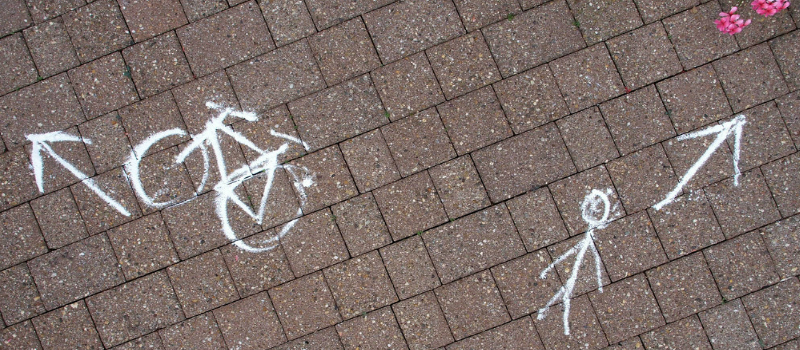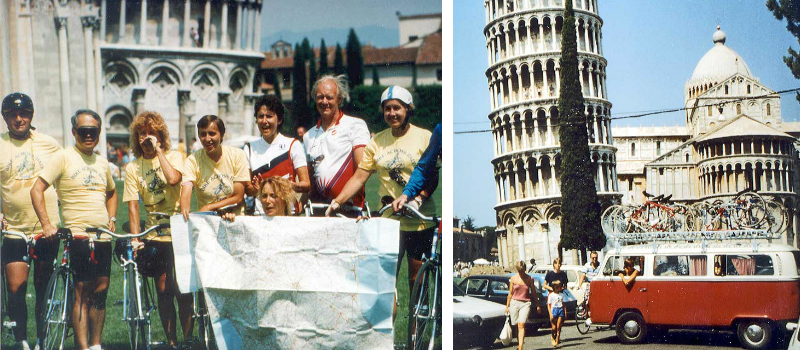Guided Independence
A History of ExperiencePlus!’s Chalk Arrows
In 1985, a group of eight cyclists in Vinci, Italy sat around after dinner. Their tour with ExperiencePlus! (then called Italian Specialty Tours, Inc.) was, at the time, missing one essential thing: chalk arrows. That is because our chalk arrow navigation system had yet to be invented.
According to ExperiencePlus! co-founder, Rick Price, at the time three tactics were employed to navigate on tour. First, a follow-the-leader scenario which necessitates the group sticking together while cycling. Second, voice commands were used to navigate – these could easily be missed or mis-remembered. Lastly, cue sheets where handed out. Which, without ubiquitous computers at the time, were a challenge to keep up to date, edit and manage.
On about day seven of ExperiencePlus!’s iconic Bike Across Italy trip from Venice to Pisa, the group got to brainstorming in Vinci. “We’d had enough days of losing people or running after them, it was an issue on everybody’s mind,” said Rick. “Somebody in the group – I don’t remember who – said, why don’t you use chalk?”
Armed with an old Clorox bottle, a funnel, a little water and a 10-kilo bag of chalk dust from the local hardware store, the first arrows were born… or poured. In those days the two-person tour leader team consisted of founders Rick and Paola. One person drove the support van and the other rode with the customers. So, to test out this new method, Rick drove and stopped at key intersections to make arrows on the road.
The arrows stuck – but a little too well. Rick remembers applying a crucial arrow at a sharp left turn outside Lucca. He stopped to watch as a big truck picked up the wet arrow on its tire and slapped about six more down the road in rapid succession. But, the concept was working – although there was room for improvement. In the hotel he grabbed a plastic cup and skipped the water; that worked like a charm.
“It was a huge breakthrough,” said Rick. “Customers loved the arrows – they didn’t have to worry about anything. They loved them then and 32 years later they still do.”
The birth of chalk arrows increased customer satisfaction, to be sure, but also unleashed a process of changes in the company. There were the predictable advancements, like writing a language of chalk and arrows that customers could easily comprehend. Much of this, Rick said, stemmed from the brain of Massimo Malpezzi – Paola’s nephew and cousin of current owners Monica and Maria Elena (Rick and Paola’s daughters).
“Massimo is the one who developed the iconology of arrows over time,” said Rick. “Like an arrow with two lines in front means there are no more arrows.”
And then there were the sporadic improvements. Rick remembers some of their arrows mysteriously vanishing once.
“We used to stay in Marradi before crossing the mountains [on the Bike Across Italy tour],” said Rick. “Once some kids washed the arrows away and customers missed a turn and they were lost! And it’s early in the tour and our cyclists don’t know yet that if you don’t see an arrow for awhile you should go back.”
“Forgetting to put the last arrow is the worst feeling,” said Rick. “Downhill out of Vinci is the classic story, if you forget the arrows into the hotel the customer is lost. They’ll come back eventually but… I’ve forgotten arrows once or twice but never again.”
Another realization came after watching semi trucks park atop and hide arrows. Again, Rick realized there was a chance for improvement such as making three arrows at a turn.
“Well spaced because a mischievous kid is not going to carry water that far to erase them,” said Rick. “And the other thing is a big 18-wheeler truck can park over two arrows without seeing them – but it cannot obscure all three arrows.”
One of the biggest revelations for Rick and Paola came in the early 1990s – the first time Rick actually followed arrows instead of creating them. Massimo had marked arrows to Meldola from Bertinoro, where he, Rick and the customers visited a winery. The plan was to stop at a pre-designated gelateria.
“I said, Max, drive the van. I’ll sweep, you make arrows,” Rick said. “So Max made arrows and I am following and the arrows are going in the wrong direction! I think, where are you taking us?”
Turns out the gelateria Rick had in mind was closed; Massimo improvised, steering Rick and the group to another ice cream stop.
“I followed [the arrows] and ended up right there,” said Rick. “It was the first time I realized I didn’t have to mark the arrows and what an extraordinary tool the arrows were because it allows the person marking to improvise if necessary. And I realized we could teach other people how to mark arrows.”
And as the direction of arrows morphed so did its medium, *the chalk itself. Of course, water disappeared long ago from the equation; somewhere along the line using bike water bottles as a ‘pen’ became the norm. Also, using the right type of chalk matters so that they don’t stick around too long – most arrows disappear with one hard rain.
“I used to go in and buy one bag at a time or buy it on the road where we need it,” said Rick. “We’ve done it all over the world like that.” Rick would go into a building supply store with a sample of what he needed, and say “I’m looking for something like that.” After all, the chalk we use is nothing more than fine sheet-rock.
Rick and other tour leaders learned to ask for chalk in countries where they didn’t necessarily know the language. Except sometimes there’s a hitch in the system – or a lump. “In Costa Rica we got some bad chalk maybe because of humidity,” said Rick. “There were chunks that wouldn’t go through the bottle – it’s impossible to mark like that. We actually were out buying screens to try and filter the chunks.”
And if, by chance, tour leaders find themselves to be in a chalk-less pickle (or its Italian equivalent, essere in un bel pasticcio, a very nice pie)?
“Some tour leaders when they ran out of chalk, rarely, used flour,” said Rick, with a smile.
Regardless of whether the arrows are made of flour or chalk, they are not only what ExperiencePlus! is famous for, but what the company – and its founders – stand for.
“It’s about freedom of doing your own thing,” said Rick. “Stop for a coffee, to use the bathroom, to take a picture. That’s what bicycling is about and that’s what the arrows allow.”
*Please note: We work hard to maintain sustainable practices on tour, including sourcing chalk that is not harmful to the environment. Read more about how we work to incorporate responsible travel practices here.



